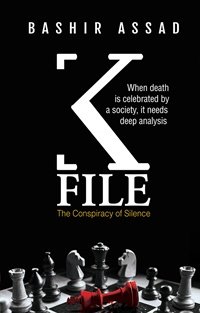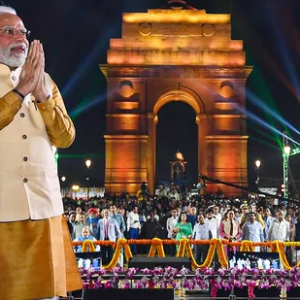What can explain the fact that one of the most beautiful places on earth has been turned into a living hell? Much of the troubles faced by the state can be attributed in the initial years to the ambitions of two men—Maharaja Hari Singh, who was looking at ways and means to remain in power and Sheikh Abdullah, who was determined to oust the Maharaja and take over the reins of the state. The Maharaja acceded to India on 26 October 1947, following Pakistan backed tribal invasion of India. It was fortuitous that Indian forces, which were flown into Srinagar Airfield on the very next day, reached just in time to halt the raiders at the outskirts of Srinagar. Over the next 14 months, the Pakistani backed forces were pushed back, till a ceasefire was declared, leaving Pakistan in control of Gilgit-Baltistan and the region of Mirpur-Muzaffarabad. With minor modifications, this has, since the Simla Accord of 1972, been sanctified as the Line of Control.
Plenty of political shenanigans took place since the accession of the state to India on October 1948. But what is generally not known is how a small coterie of people, whom the author of K File: The Conspiracy of Silence, Mr Bashir Assad describes as the Mullah caste—the Geelanis, Muftis, Shah, Handanis, Naqshbandis, Andrabis, Bukharisetc, achieved a stranglehold over the state, dominating the state’s political landscape as well as its bureaucracy. This was the clan which moved into Kashmir from Arabia, and slowly established dominance over the original inhabitants of Kashmir. Today, this small group, representing just about 3 per cent of the Valleys Muslim population, has a stranglehold on the state’s politics and its bureaucratic structure. Surprisingly, this aspect of the politics of Kashmir has been so well hidden from the public gaze.
Article 370 was never a demand of the people of Jammu and Kashmir. It was not even the demand of Sheikh Abdullah! Why India’s first Prime Minister, Pt. Jawaharlal Nehru insisted on including it in the Constitution remains a mystery. DrBhimraoAmbedkar was vehemently imposed to the same and he made this known in no uncertain terms, while the Constitution was being drafted. That is why it was kept as a temporary provision. Would the history of the State have taken a different trajectory if such a provision had not been placed on the statute book? The answers can only be hypothetical. However, one thing cannot be denied. The seeds of separatism were sown with the inclusion of Article 370 in the Constitution. And later, with the promulgation of Article 35A through a Presidential Ordinance, free rein was given to the politicians of the Valley to keep the embers of a separatist philosophy alive.
These aspects are not covered in the book, which is rightly focussed on a singular theme; the radicalisation of a society that had absolutely no reason to take to that path. How is it that a society, which for millennia symbolised a culture of inclusiveness, now celebrates death through jihad as a means of gaining salvation? Why is death celebrated? Why is the word of the hate mongers and terror perpetrators taken as the truth? Why have the scholarly institutions of traditional Islamic jurisprudence been demolished in Kashmir? How and why have we allowed the youth of Jammu and Kashmir to be swayed by the force of a radical ideology which seeks the killing of those not conforming to the Muslim faith as a righteous act; which believes that it is a moral imperative to take up arms against the state; and which is ideologically primed to the extent of believing that laying down one’s life for the cause of jihad is an act that will win rewards in heaven? Once we find answers to these questions, we will be a step closer to understanding the causative factors of violence in the state of J&K. Only then, can we begin to look at policy options to address the alienation that has taken place.
Bashir Assad is a son of the soil. Born in South Kashmir and having being educated in a Madrassa, he was privy to every aspect of life in the state and thus is perhaps more competent than others to expound on the radicalisation that has swept through the Valley and destroyed its Sufi culture. Unknown to many,Assad has laid bare the fact that the spread of radicalisationin the state is linked to the growth of the Jamaat-e-Islami in Kashmir. The process started sometime in the mid-1960’s, when Maududi’s literature was first made available. It gained impetus after 1977, ostensibly with Pakistani backing—a throwback to the Pakistani defeat in the 1971 Liberation war. With the advent of armed insurgency in 1989, the process took on a menacing hue.
All these aspects are well covered in the book. Most alarmingly, while the government banned the Jamaat-e-Islami and its Falah-e Aam Trust (Educational Wing) in 1992, it simultaneously issued orders for the absorption of the teachers of Falah-e-Aam Trust in government schools. And thus began the onslaught of radical ideology on young and impressionable minds. It is incomprehensible to understand why this was done by the State. A charitable explanation is that the state leadership was naive. More likely however, is the possibility that they were complicit. Be that as it may, the result today is that the educational system has been taken over by a radicalised clergy and even government jobs are available only to those who support the Mullah caste. A small group of people, who had no Kashmiri roots and who comprise barely three per cent of the Muslim populace, are thus now ruling the roost.
Why did we allow this to happen? Both the Centre and the State must accept responsibility for the mess that has been created in Kashmir. The Mullahs mentioned earlier—the Geelanis, Muftis, Shah, Handanis, Naqshbandis, Andrabis, Bukharis et al, are the ones spearheading the Azadi narrative, and linking it with Islam. Thus the slogan—‘Azadikamatlabkya, La illahaillallha’. The factors which drive the terrorist movement in the state have been variously attributed in public discourse to poverty, a sense of alienation, joblessness, and many other factors. But the real cause, radicalisation of the minds of the youth, is rarely discussed. That is the nature of the secular state, where to speak of an issue in religious terms gets the individual labelled as communal! But unless the facet of radicalisation—something that has been ongoing for close to over five decades—is addressedpeace cannot return to the Valley.
Surprisingly, the Mullahs exhort the common Kashmiri, the original inhabitants of the land to make sacrifices for the cause. Yet they keep their children safely ensconced in other parts of India, where they receive a good education. These Mullahs have amassed fortunes in the name of the poor and have cornered political and administrative power. Their shackles need to be broken if Kashmir is to return to peace. The abrogation of Article 370 and 35A is but a first step in this direction. The road ahead is, however, going to be long and arduous one, but it is one that must be traversed.
Bashir Assad’s book must be read to understand the way the narrative has been shaped and exploited by a small group for their ends. It gives out a facet of Kashmir from the perspective of a son of the soil that has never before been penned, because of the risk to life and limb that such an account would invariably bring. It is thus a brave account, giving out in explicit detail how the Valley got radicalised and in the process, exposing the author and his family to great risk. The author appears to have a soft corner for Sheikh Abdullah and his brand of politics, but that is par for the course. There is also an oblique reference in passing, linking the growth of the Jamaat to the rising influence of the RSS. This may be the popular narrative in Kashmir but it is devoid of substance and is a mere rationalisation of the acts of the Jamaat. The radicalisation of the Valley was a deliberate act, well thought out and planned by a rabid clergy, supported from across the border and was not a result of internal causes. It is a sad reflection of our times, and of the state of India’s professed secularism, that this philosophy was not nipped in the bud and allowed to flourish till it had all but consumed the state.
For those looking at conflict resolution in the State of Jammu and Kashmir, post the dramatic revocation of the special status of the state on 5 August 2019, this book must be read. It provides an essential backdrop to understanding the situation in the Valley, which makes it an indispensable read for policymakers, think tanks, personnel form the Armed Forces, Police personnel and even the lay public. A few printers devils have entered into the book which otherwise has been well produced by Vitasta Publications. These need to be corrected in the next edition. Overall, a very brave book on Kashmir, for which the author must be commended.



